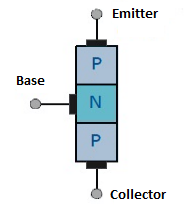PNP transistor is a semiconductor device with a structure opposite to that of an NPN transistor. It has an N-type layer situated between two P-type layers.
In a PNP transistor:
- The charge carriers are holes (vacancies).
- Current flows from the emitter to the collector.

When you apply current to the base of a PNP transistor, which controls the current between the emitter and the collector, the transistor turns on. Current flows from the collector to the emitter, amplified by the base current. When no current is applied to the transistor’s base, the transistor is off, and no current flows between the emitter and the collector.
To open and activate a P-N-P transistor structure, you need to apply a “-” to its base.

PNP transistors are also used in various applications, such as in output stages of amplifiers, power supplies, electronic switches, and more. In some cases, PNP transistors may be preferred when higher voltage levels are required compared to NPN transistors.
